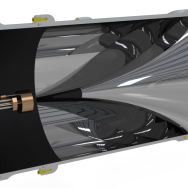Sending an atomic clock onboard a spacecraft to fly close to the sun might be the trick to uncovering the nature of dark matter, suggests a new study published in Nature Astronomy.
Dark matter makes up more than 80% of the mass in the universe, which we know because we can see its effects on galaxies and stars—but so far, no one has been able to directly detect it, despite decades of experimental efforts.
A group of scientists has proposed a new way to look for this mysterious dark matter, using the technology known as atomic clocks.
Atomic clocks, which tell time by measuring the rapid oscillations of atoms, are already at work in space, enabling the Global Positioning System (GPS). These clocks are so precise that they will not lose even a second of time in billions of years. This caught the attention of researchers, who thought they might be able to use this unique precision to detect dark matter.
"This is a beautiful synergy between particle theorists and a quantum expert, and we have been in contact with NASA solar probe researchers to realize this proposal," said lead author Yu-Dai Tsai. "There are many new exciting directions in the intersection of all these fields."
The study, published Dec. 5, was led by Tsai, who initiated the project at the University of Chicago and Fermilab and is now a postdoctoral researcher at the University of California, Irvine, along with collaborators University of Delaware physicist Marianna Safronova and Joshua Eby of the University of Tokyo and the Kavli Institute for the Physics and the Mathematics of the Universe.
Constants of nature
“Dark matter is one of the most important remaining mysteries in astronomy and cosmology, given its unknown and elusive nature,” explained Tsai. “If we could find dark matter and understand its properties, we can understand the evolution of our universe.”
But because scientists are not even sure exactly what dark matter is and how it behaves, it’s been difficult to even design ways to find it.
Consequently, scientists have come up with many theories of what dark matter could look like. One such theory is known as “ultralight” dark matter. If this ultralight dark matter exists the way the theory predicts it does, it should cause oscillations in the very constants of nature—such as in the mass of electrons or the strength of the electromagnetic force.
This caught the attention of the scientists. They knew that atomic clocks use these constants of nature to operate—so any change in these constants of nature should show up in the functioning of the atomic clock.
Specifically, atomic clocks—sometimes known as quantum clocks—operate by carefully measuring the frequency of photons emitted in transitions of different states in atoms. Ultralight dark matter in the vicinity of the clock experiment could modify those frequencies, as the oscillations of the dark matter slightly increase and decrease the photon energy. That would change how the clock ticks.
To have the best chance of working, the scientists said, the clocks should be positioned close to the sun, where theory predicts that the dark matter should clump in a halo.
The technology to put their theory to the test already exists, the scientists said. The NASA Parker Solar Probe, operating since 2018, is the closest artificial spacecraft to the sun in human history.
“The Parker Solar Probe is not returning to Earth, but the next-generation solar probes can carry a precise quantum clock on board,” said Tsai. “Such a space mission would have the ability to carry out our proposed study.”
The Parker Solar Probe is named after the late great physicist at the University of Chicago, Prof. Eugene Parker, who has made significant contributions to solar physics. "I was an associate fellow at the University of Chicago when we initiated the project, and Parker's pursuit inspired us on this project,” Tsai said.
"There are so many more exciting topics to explore," Tsai continued. "Beyond this work, space missions can also provide data for planetary defense. In our related works, we also utilize these data to study questions such as local dark matter density and the possibility of a fifth force of nature beyond the Standard Model of Physics. Quantum sensors, including atomic clocks, can improve the precision of these measurements and provide us with stronger tests for fundamental physics."
Citation: “Direct detection of ultralight dark matter bound to the Sun with space quantum sensors.” Tsai, Eby, and Safronova, Nature Astronomy, Dec. 5, 2022.
Funding: National Science Foundation, Simons Foundation, Fermilab/U.S. Department of Energy, World Premier International Research Center Initiative (MEXT), Japanese Society for the Promotion of Science, European Research Council.
—Adapted from articles published by Kavli IPMU and the University of Delaware.

